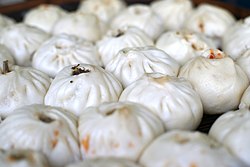Nunu

Meat-filled baozi for sale in a market
|
|
| Alternative names | Bao, humbow, nunu, pau |
|---|---|
| Type | Filled steamed bread |
| Place of origin | China |
| Variations | Dabao, xiaobao |
| |
|
| Baozi | |||||||||||||||||
|
"Baozi" in Chinese characters
|
|||||||||||||||||
| Chinese | 包子 | ||||||||||||||||
|---|---|---|---|---|---|---|---|---|---|---|---|---|---|---|---|---|---|
|
|||||||||||||||||
| Transcriptions | |
|---|---|
| Standard Mandarin | |
| Hanyu Pinyin | bāozi |
| IPA |
[páu.tsɨ] ( |
| Yue: Cantonese | |
| Jyutping | baau1 |
| Southern Min | |
| Hokkien POJ | pau-á |
Baozi (Chinese: ![]() 包子) are a type of steamed, filled bun or bread-like (i.e. made with yeast) item in various Chinese cuisines, as there is much variation as to the fillings and the preparations. In its bun-like aspect it is very similar to the traditional Chinese mantou. It can be filled with meat and/or vegetarian fillings.
包子) are a type of steamed, filled bun or bread-like (i.e. made with yeast) item in various Chinese cuisines, as there is much variation as to the fillings and the preparations. In its bun-like aspect it is very similar to the traditional Chinese mantou. It can be filled with meat and/or vegetarian fillings.
Two types are found in most parts of China and Indonesia: Dàbāo (大包, "big bun"), measuring about 10 cm across, served individually, and usually purchased for take-away. The other type, Xiǎobāo (小包, "small bun"), measure approximately 5 cm wide, and are most commonly eaten in restaurants, but may also be purchased for take-away. Each order consists of a steamer containing between three and ten pieces. A small ceramic dish is provided for vinegar or soy sauce, both of which are available in bottles at the table, along with various types of chili and garlic pastes, oils or infusions, fresh coriander and leeks, sesame oil, and other flavorings.
According to legend, they were invented by the Chinese scholar and military strategist Zhuge Liang during the Three Kingdoms period (3rd century AD)..
包子(Baozi) is a variation of 馒头(mantou) — which was also invented by Zhuge Liang — but with fillings. At first it was also called by the same name 馒头(mantou). By the time of Northern Song dynasty (960-1127 AD), the current name 包子(baozi) was used for the buns with fillings, as recorded in books of the Song dynasty. Meanwhile, 馒头(mantou) remained the name of steamed buns without fillings.
...
Wikipedia
